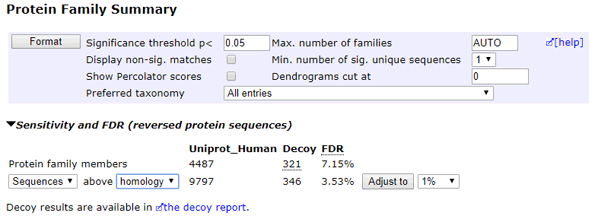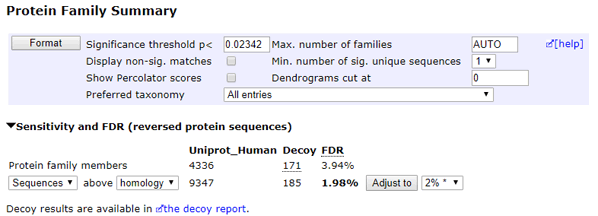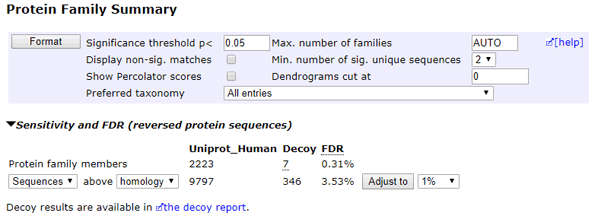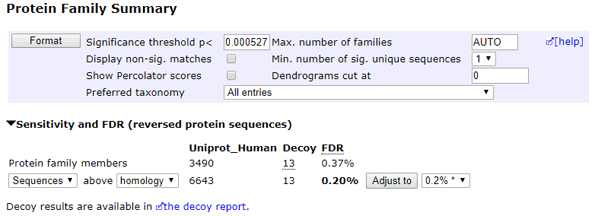Decoy databases
Introduction
Many journals impose guidelines for the reporting of database search results, designed to ensure that the data are reliable. This was initiated by the Editors of Molecular and Cellular Proteomics, who organised a workshop in 2005 to discuss the issues, culminating in the "Paris Guidelines". The current MCP guidelines require "For large scale experiments, the results of any additional statistical analyses that estimate a measure of identification certainty for the dataset, or allow a determination of the false discovery rate, e.g., the results of decoy searches or other computational approaches."
This is a recommendation to repeat the search, using identical search parameters, against a database in which the sequences have been reversed or randomised. You do not expect to get any true matches from the "decoy" database. So, the number of matches that are found is an excellent estimate of the number of false positives that are present in the results from the real or "target" database. This approach has been described in publications from Steven Gygi’s group, e.g. Elias, J. E., et al., Comparative evaluation of mass spectrometry platforms used in large-scale proteomics investigations, Nature Methods 2 667-675 (2005).
If TP is true positive matches and FP is false positive matches, the number of matches in the target database is TP + FP and the number of matches in the decoy database is FP. The quantity that is reported is the False Discovery Rate (FDR) = FP / (FP + TP)
While this is an excellent validation method for MS/MS searches of large data sets, it is not useful for a search of a small number of spectra, because the number of matches is too small to give an accurate estimate. Hence, this is not a substitute for a reliable scoring scheme, it is more a good way of calibrating it.
A decoy search can be performed automatically by choosing the Decoy checkbox on the search form. If you prefer to create a decoy database and search it separately, a utility for this purpose is available below.
Automatic Decoy Search
For an automatic decoy database search, choose the Decoy checkbox on the search form. During the search, every time a protein sequence from the target database is tested, a decoy sequence of the same length is automatically generated and tested. The matches and scores for the decoy sequences are recorded separately in the result file. When the search is complete, the numbers of matches and the false discovery rate are reported in the result header.
This screenshot shows an example of the decoy statistics for an MS/MS search as displayed in the Protein Family Summary. Only limited FDR information is displayed in the Select and Peptide Summaries:

Peptide FDR
Referring to the screen shot above, the drop-down at the bottom left switches between sequences (only the highest scoring match to a given sequence is counted, charge state and modification state are ignored) and PSMs (all significant peptide sequence matches are counted). The adjacent drop-down switches between using the Mascot homology threshold and the Mascot identity threshold to judge significance. In most cases, the Mascot identity threshold is over-conservative, and better sensitivity at a given false discovery rate will be achieved by using the homology threshold. In this example, the default significance threshold (5% for PSMs) is giving an actual FDR for peptide sequences of 3.53%.
The controls at the bottom right (Protein Family Summary only) can be used to automatically adjust the significance threshold so as to achieve a specified false discovery rate. If we choose 2% for the homology threshold and Adjust to, the significance threshold is shifted to 0.02342 to give the best possible peptide sensitivity at a false discovery rate less than or equal to the requested value. The count of significant sequences drops from 9797 to 9347

The choice of values in the drop down list is a global setting in the options section of mascot.dat.
TargetFDRPerCent 0.1, 0.2, 0.5, 1+, 2, 5
The numbers are percentages and the plus sign doesn’t appear in the drop down list, it indicates the default selection. Clicking on the Decoy link will load a report for the decoy search, just as if it was a separate search of a decoy database.
Decoy statistics are always calculated from all matches. Changing the number of hits to be displayed or setting a cut-off on the ions score or expect value will have no effect. Sometimes, it will not be possible to achieve the requested false discovery rate; the significance threshold will be pushed to its limit and a warning displayed. The automatic decoy search is equivalent to searching separate target and decoy databases.
Algorithms for constructing decoy sequences are described in G. Wang, et al. (2009), "Decoy Methods for Assessing False Positives and False Discovery Rates in Shotgun Proteomics", Anal Chem. 81(1):146-159. The two most widely used are:
- Method 1: reversed protein sequences
- The default for MS/MS searches with a fully specific or semi-specific enzymes
- Method 3: randomised protein sequences
- The default for MS/MS searches with enzyme None and all PMF searches. This was the default method in Mascot 2.3 and earlier. If the target database is nucleic acid, it is the original sequence that is randomised, not the translation. The average amino acid composition of the decoy sequences is the same as the average composition of the target database.
The defaults are specified in the options section of mascot.dat. Refer to the Setup & Installation Manual for further details.
Protein FDR
Protein false discovery rate is estimated using a MAYU type of approach. The rules of the game:
- Only peptide sequence matches (PSMs) with significant scores are used as evidence for proteins. Proteins with shared PSMs are grouped into families. Each distinct family member contains at least one unique peptide sequence, not shared with other family members.
- The protein count used for FDR is a count of family members. That is, if the report contains 2 families, one with 4 members and the other with a single member, this counts as a total of 5 proteins. Same-set, sub-set and intersection proteins are not counted.
- A protein identification is considered to be true positive if it contains at least one true positive PSM. A protein is a false positive only when all of its PSMs are false positives.
- The number of wholly false proteins is estimated by taking the count of decoy proteins and using a hypergeometric distribution to estimate how many of the target proteins contain both true and false PSMs, hence should be counted as true. This correction is important whenever a large fraction of entries may be true hits.
- The main differences from the MAYU approach are that we do not make a separate estimate of the FDR for one-hit wonders and we do not partition the database by protein size. We use a simpler estimate for the number of false proteins in the target database, based on the assumption that the number of decoy proteins never reaches a significant proportion of the database size.
- Usually, database redundancy causes protein inference ambiguity, meaning we could account for the PSM evidence using several sets of proteins. A protein FDR of 1% only tells us that 1% of the proteins listed are wholly false. This doesn’t mean the other 99% are “correct”. In particular, where there are same-set proteins, we cannot say which one is “correct”.
The two screen shots above show how the protein FDR is related to peptide FDR. Reducing the peptide FDR from 3.53% to 1.98% reduced the protein FDR from 7.15% to 3.94%. Setting a minimum count of significant sequences can have an even stronger effect. In this particular example, if the peptide FDR is 3.53% but we eliminate "one-hit wonders" by setting the Min. number of sig. unique sequences to 2 (then choose Format), the protein FDR drops to 0.31%.

However, you may be able to report a lot more proteins for the same FDR by keeping the "one-hit wonders" but setting a lower peptide FDR, as shown below. The combination of peptide FDR and Min. number of sig. unique sequences that gives the best sensitivity for a given FDR will be data-set dependant, so use trial and error.

Peptide Mass Fingerprint FDR
Conventionally, a decoy database search is only used for validating searches of MS/MS data. It is not possible to get a false discovery rate for a peptide mass fingerprint, but it can be informative to see the result of repeating a PMF search against a decoy database, especially if the match from the target database is close to the significance threshold, or if there is reason to think the experimental values or search parameters may be producing a false positive.
This screenshot shows an example of the decoy report for a PMF search:

Manual Decoy Search
A Perl script to reverse or randomise database entries can be downloaded here: decoy.pl.gz. Unpack using gzip or WinZip. Note: Windows file associations can cause this file to be unpacked automatically when downloaded using Microsoft Internet Explorer on a Windows PC. If you cannot open the file in Winzip, try to open it in a text editor like WordPad. If it looks like text, then it has been unpacked, and you only need to rename the file to decoy.pl.
Execute without arguments to get the following instructions.
Usage: decoy.pl [--random] [--append] [--keep_accessions] input.fasta [output.fasta]
- If –random is specified, the output entries will be random sequences with the same average amino acid composition as the input database. Otherwise, the output entries will be created by reversing the input sequences, (faster, but not suitable for PMF or no-enzyme searches).
- If –append is specified, the new entries will be appended to the input database. Otherwise, a separate decoy database file will be created.
- If –keep_accessions is specified, the original accession strings will be retained. This is necessary if you want to use taxonomy and the taxonomy is created using the accessions, (e.g. NCBI gi2taxid). Otherwise, the string ###REV### or ###RND### is prefixed to each original accession string.
- You cannot specify both –append and –keep_accessions.
- An output path must be supplied unless –append is specified.
- If the database is nucleic acid, no need to specify –random. A simple reversal will effectively randomise the translated proteins
Title line processing assumes that the accession string is between the ">" character and the first white space. If this is not the case, you may need to edit the script to make it usable. If creating a concatenated database, the Mascot parse rules will probably need to be rules 4 and 5 if they are to work for both original and decoy entries. This makes it difficult to configure taxonomy.
The Mascot report scripts cannot display the match counts and FDR after a manual decoy search. One option is to export the results to Excel using the custom CSV format. To avoid outputting duplicate matches when a query matches more than one protein, make sure to set the number of hits to 1, include the unassigned list, and delete any matches with rank greater than 1.
If using a concatenated database, an easier alternative is to use a simple Perl script that can be downloaded here: fdr_stats.pl.gz. Unpack using gzip or WinZip. Note: Windows file associations can cause this file to be unpacked automatically when downloaded using Microsoft Internet Explorer on a Windows PC. If you cannot open the file in Winzip, try to open it in a text editor like WordPad. If it looks like text, then it has been unpacked, and you only need to rename the file to fdr_stats.pl.
Copy the script to the Mascot bin directory and execute without arguments to get the following usage instructions:
Output counts of matches for a specified FDR
The program must be run from the mascot bin directory
Usage: fdr_stats.pl fdr_goal thresh_type decoy_string result_file [debug]
Example: fdr_stats.pl 0.01 homology "DECOY_" ../data/20111213/F123456.dat
fdr_goal is the desired peptide FDR (enter 0.01 for 1%)
thresh_type is either identity or homology
decoy_string is the substring in a protein accession that identifies a decoy entry
result_file is the path to a Mascot result file
add optional final argument "debug" to get details of all matches (tab separated)What makes a good decoy database?
The Gygi group advocate searching a database in which the target and decoy sequences have been concatenated. This means that you will only record a false positive when a match from the decoy sequences is better than any match from the target sequences. A more conservative approach is to search the two databases independently. If the Mascot score threshold for a given spectrum is (say) 40, and we get a match of 60 from the target database and 50 from the decoy database, this would not count as a false positive from a concatenated database, but it would count as a false positive if the two had been searched independently.
There is also the question of whether to reverse or randomise. If you simply reverse a sequence, and then do the search without enzyme specificity, you may get a misleading picture of the false positive rate because, sometimes, you will get a mass shift at each end of a reversed peptide that just happens to transform a genuine y series match into a false b series match or vice versa. Similarly, a reversed database is not suitable for verifying a peptide mass fingerprint score, because half of the tryptic peptide mass values will be unchanged. (Those that have the same residue at the C-terminus and flanking the N-terminus). The main objection to using a randomised database is that the number of distinct peptide sequences in the decoy is likely to be larger than in the target because real protein sequences have a degree of redundancy, which is lost on randomisation.
